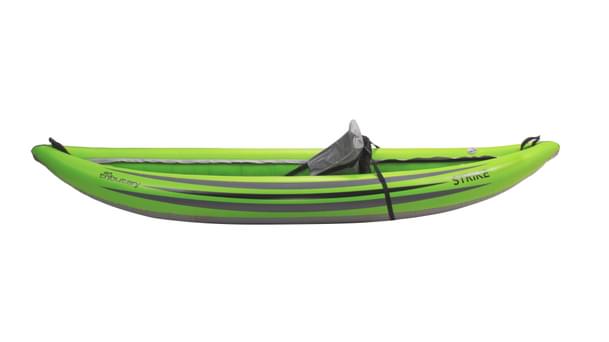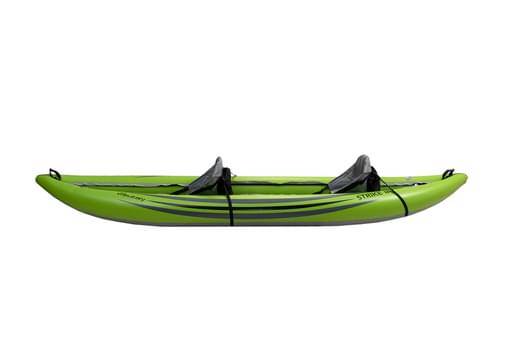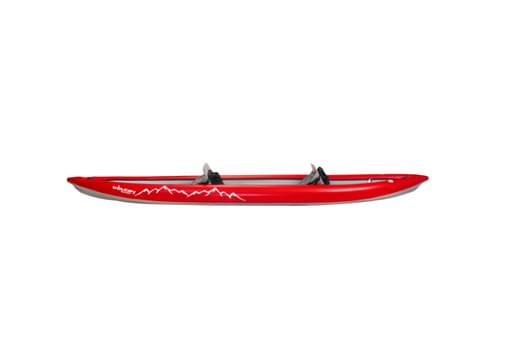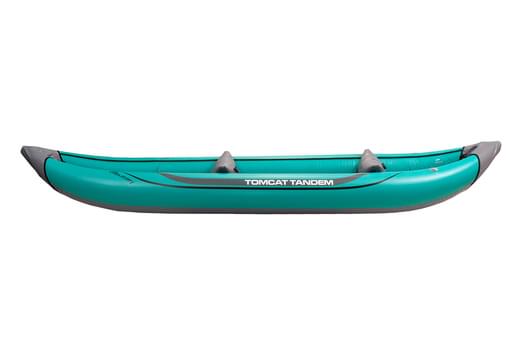- Home
- Gear & Reviews
- SVX100DS River X K1 Kayak
SVX100DS River X K1 Kayak

SVX100DS River X K1 Kayak Description
The SVX100DS River X K1 Kayak is a kayak brought to you by Sevylor. Read SVX100DS River X K1 Kayak reviews or submit your own review to share with the paddling community. Check out a few other kayak recommendations below or explore all kayaks to find the perfect one for you!
Sevylor
SVX100DS River X K1 Kayak Reviews
Read reviews for the SVX100DS River X K1 Kayak by Sevylor as submitted by your fellow paddlers. All of the reviews are created and written by paddlers like you, so be sure to submit your own review and be part of the community!
I recently purchased the…
I own the older XK1 which has an inflatable tube floor and it works great in self-bailing mode. I had a 5 mile paddle with a boat full of water which was a pain. To add to my experience, the first rock I dragged across slit the bottom open to the tune of a 9 inch gash. Once again the older models superior hull design never had such a problem. I did enjoy good maneuverability in the white water where the boat is swamped by the waves. The problem was the dead water where the boat was swamped by the self-bailing holes. The self-bailing holes are the size of golf balls. It also doesn't come with the thigh straps which were standard with the older model. The bag is superior as it actually fits the boat. I do not have any idea as to performance with the bailing holes closed as I beat feet back to the store to return the boat.
My opinion is low as the new model is a definite step back from previous models. I give it a four.
After five months of paddling…
Strong? Value for money, yet well made. With great effort a friend managed to hole the outer hull bottom by "jiggling" vigorously whilst stuck on a sharp boulder in the middle of a water-fall. The hole was tiny though and easily repaired. It made no difference other than adding another self-draining port. The boat was severely pinned against trees in a raging river on another occasion but showed no stress. However the rubber skeg has ripped caused by running boney creeks and I will made an effort to glue it back on. It may be a better creeker without it, as it does add draft and tends to reduce boulder slippage. Whether tracking will be badly affected I am not sure but I have paddled with it ripped in class 3 water and found no difference.
Positives include high stability, light weight,a good bag and a good quality pump. All my floors fitted as specified, although the boston valve pressure gauge is difficult. I merely pump the hulls up (3 psi) until the wrinkles disappear and the floor as hard as I can (7 psi). There are plenty of attachment points for strapping down gear and the seat is very comfortable. Do you get wet in white water? Absolutely soaked! The boat handles well even when filled totally with water, in fact, it might even handle better in higher grades with the added weight at times! It is nippy and easy to turn but buy a good quality white-water paddle. On flat slow water it convinces you that it is a creeking and river-running boat.
A gripe? Getting spare parts in Australia is hopeless. Contacting Sevylor is nigh on impossible and they most certainly do not communicate back with you. Perhaps you need to go through your dealer? But be warned! This is a worry because the pump nozzle required for the 7 psi floor is a special one! Don't lose it! The Boston valves on the hulls aren't a problem though, plenty of generic fittings.
Fit thigh braces! Absolutely crucial in white water. You will swim more rapids than paddle them otherwise. Why they do not supply them as standard in a white water boat is a question you could ask Sevylor if they ever answered!
Take care to avoid holes if possible. Keepers tend to gobble up light inflatables like this one and have done it to me.
But in summary, a worthy and low-cost entry into white water. Be aware that the boat tends to make you appear better than you are and paddle it positively all the time! But, it's good.
I recently purchased this…
Pros: This ducky is significantly stiffer, particularly the floor, which improves the performance at all levels. The increased stiffness comes from the use of a newer material throughout the boat that allows for higher side chamber pressures, 3 psi (perhaps greater durability) and the use of a separate and removable/inflatable high pressure (7 psi) floor. The older version has side tube sleeves that hold the side tubes in place when inflated. The new version eliminates these side tube sleeves which is nice because it will be easier to make sure all water is drained and the boat is dry between usage and before seasonal storage.
The high pressure stitched floor (7 psi) has several advantages over the old model. It makes this version a great deal stiffer (no exaggeration-you'll have to feel one when inflated) and flatter shaped on the bottom. Set aside and sitting alone, the floor resembles a surf board. These improvements make it easier and more fun to surf and plane the waves. I believe there is a small increase in initial acceleration and tracking due to the increased overall stiffness of this boat. I believe the stiffer floor reduces the boats tendency to spin because one's rear isn't depressed as far down into the water.
D-Rings. One of the things we've liked is that these models have enough D-rings to easily allow tying down coolers and gear. Many models more expensive don't have as many. There are 2 in the front (one on each side) and 4 in the rear, 2 on each side behind the seating.
Foot rest. It's now a hard plastic with non-sharp edges and better sized to eliminate chaffing against the side tubes.
Seating. The new model Velcro's to the floor. Aside from that, it's almost identical to the older model and also uses straps on each side attached to D-rings. Like the older model it has reasonable back support and cushioned bottom. I might get an extra one to install on my old SOT. The supplied seat has a removable fanny pack attached to the back of the seat. This fanny pack has a main mesh pocket (Velcro closure) that provides ample room for carrying some items. I carry a repair kit (came with boat and you can purchase them), spare Boston valves (you'll most likely need them at some point of ownership), fire starter, a couple of small bungee cords and a few other items. There are 2 each side mess pockets for water bottles or whatever your preferences are.
Inflation. The boats come with a double action pump, special fitted/slotted hose and several special/slotted adaptors for inflating the chambers. These also come with an air pressure gauge and a fitting for the side and floor chambers that the gauge screws into to allow for taking a pressure reading. Pro: pump works well and one can use it to deflate or pump water out. Con: if you lose the adaptors, you can add air by using your mouth but you'll be significantly under inflated; especially the floor.
Measuring air pressure. The side tubes take 3 psi max and the high pressure floor takes 7 psi max. On the pro side, the fitting works like a charm when used on the high pressure floor. On the con side, the fitting hasn't worked for taking the pressure readings on the side chambers for anyone we know. And that includes employees at REI in SLC who are as frustrated as we are.
Not only can we not get a reading on the side chambers but attempting to get a reading and read it releases air from those damn Boston valves. The Boston valves point downward slightly when the side chambers are inflated. Use of the fitting and gauge requires one to try to pull the valve upward for viewing and air begins to leak from the Boston valve. Not that that matters as we can't get a reading anyway.
Storage bag. The supplied storage bag is adequate for the size of this boat.
Cons. Thigh straps. The older model came with thigh straps but the newer one doesn't. This is a white water boat and we can't understand why Sevylor didn't include it. This forces the buyer to take on an additional cost and order one through a dealer which is a hassle. Their website and supplied brochure/manual did not include any part numbers for anything.
Tracking fin/skeg. There is a rubber fin/skeg about 2' long and 2-3" deep on the bottom in the center of the boat. I've got to bring this issue up but honestly not sure where my feelings are at this time. Is the fin a Pro or a Con? I've not yet taken this on anything demanding or difficult and I'm not an expert, but I'm leaning towards Con.
This is a white water boat and as such I'd have thought that maneuverability would be more important than tracking. I'd like to pick the mind of the designer as to why they felt this was a needed addition.
On calm stretches and when paddling downstream against a headwind, the boat seems less likely to spin as much and the added tracking is nice. On the other hand, it isn't necessary. I'm concerned about how much strong eddies and currents will impact stability when I cross through them. I've had a few close calls already and felt that this rubber fin might have to be cut off.
Definitely on the downside is that I have more draft now than without it. I've gotten hung up on some of the same parts of the local river at the same flow when the fin got stuck on a rock or gravel bar that I'd usually clear. Also, the rubber fin seems to be easier for rocks to maintain a hold onto than the rest of the bottom's material. Water hydraulics would push the older boat off a rock more easily.
Ferrying on calm sections is improved with the fin but more difficult and tricky when I encounter faster and more powerful sections. I'll have a better idea regarding this fin when I get this model up on something like the Snake River up by Jackson, Wyo.
Trimming and seat adjustment. On my older model, I was able to place the seat in the middle/balance point of the boat but I can't do that with the newer one. After I add a small cooler with some food and beverage, it would trim nicely. Now, however, I've had to place the seat further back in the boat making it stern heavy all the time. I haven't taken measurements vs my older model but I've had trouble finding a comfortable knee bend after I added my thigh straps off my older model. The foot rest isn't as adjustable as the older model.
Wet ride and Rocker. The newer model has less rocker (straighter bow & stern) and the additional stiffness makes for a wetter ride as this model punches through, rather than ride up and over bigger waves.
Drain holes. The newer model has 2 on each side and the older model had 3 on each side. The newer model doesn't drain as quickly.
Pieces and parts. There's enough important and necessary parts that one should carry them along. However, keeping them all together where they won't get lost or separated from your ducky is a problem. Normally, if I was on a short float, it probably wouldn't be much of an issue, but if I was on a long float it is. There's the pump, several fittings for inflating the chambers (loosely attached to pump hose), the pump hose which has a special slot in one end to fit the floor, the pressure gauge and the "fittings" for the gauge to take pressure measurements. If you lose the floor valve hose fitting, you won't be able to inflate it enough.
Boston valves. Simple and they work but can be such a pain. You can lose them during deflation and may not know it came off until you're beginning to inflate it the next time. The keeper ring can come off. Also, air can leak around the base if/when you pull up or push down on them (or a cooler pressing against them) when attempting to inflate or take a pressure reading.
Set up. I don't want to blow this out of proportion. Setting up and inflation is now more complicated and time consuming. Enough so for me that I've left mine inflated since I got it a few months ago. I will refine the process over time and will offer a few tidbits here. Don't fully inflate the sides before installing the floor and don't try to install the floor when it has much, if any, air in it. You can fully deflate the entire boat, with the floor installed, roll it up and stuff it in the storage bag. The high pressure floor has cut outs on its sides to match the drain holes on the bottom and each end fits into sleeve loops at the bow and stern flooring.
It's difficult to adjust the flooring to fit over the drain holes and at the same time to pull/push/cajole the ends into their sleeves and get the floor smoothed out without humps. I went through several repeated processes of installing, pulling and pushing the inflatable floor to line up over the drain holes, getting the ends into their sleeves, inflating it up only to have a hump appear in the area immediately before the seat where the tracking fin/skeg begins and then deflating the floor and beginning all over. Having said all this, one of my good friends has left his floor installed, deflated and doesn't seem to have the inflation problem I've had. On my older model, I'd have some problems fitting the side tubes into their sleeves, but it was easier to adjust.
A note on inflation. Trouble with side chambers/Boston valves. I've not yet inflated the floor to it's recommended 7 psi. I've only reached 5.75 and the bottom is very stiff at that level-just can't imagine what it's like at 7 and pumping it up to that level would take more effort than I'd feel comfortable with. And although we can't get a pressure reading on the side chambers, we're using the old method-pump it up to what feels about right.
Overall rating: 7 of 10. I don't know what a 10 ducky would be like but I know it's not this boat. It performs well and the price is where I can afford one. Would I get another one? At this price, yes.



